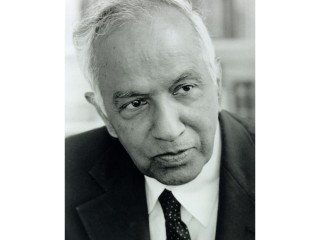
Subrahmanyan Chandrasekhar biography
Date of birth : 1910-10-19
Date of death : 1995-08-21
Birthplace : Lahore, India
Nationality : Hindi
Category : Science and Technology
Last modified : 2010-10-19
Credited as : Physicist and astrophysicist, discovery of Chandrasekhar Limit - mathematics, awarded the Nobel Prize in Physics in 1983
0 votes so far
Subrahmanyan Chandrasekhar was born on October 19, 1910 in Lahore. His father, Chandrasekhara Subrahmanya Ayyar was an officer in Government Service in the Indian Audits and Accounts Department. His mother Sita was a woman of high intellectual attainments. C.V. Raman, the first Indian to get Nobel Prize in science was the younger brother of Chandrasekhar's father. Till the age of 12, Subramanyan Chandrasekhar had his education at home under his parents and private tutors. In 1922, at the age of 12, he attended the Hindu High School. He joined the Madras Presidency College in 1925. Subrahmanyan Chandrashekhar passed his Bachelor's degree, B.Sc. (Hon.), in physics in June 1930. In July 1930, he was awarded a Government of India scholarship for graduate studies in Cambridge, England.
Subrahmanyan Chandrasekhar completed his Ph.D. degree at Cambridge in the summer of 1933. In October 1933, Chandrasekhar was elected to a Prize Fellowship at Trinity College for the period 1933-37. In 1936, while on a short visit to Harvard University, Subrahmanyan Chandrasekhar, was offered a position as a Research Associate at the University of Chicago and remained there ever since. In September 1936, Subrahmanyan Chandra Shekhar married Lomita Doraiswamy. She was her junior at the Presidency College in Madras.
Subrahmanyan Chandrasekhar is best known for his discovery of Chandrasekhar Limit. He showed that there is a maximum mass which can be supported against gravity by pressure made up of electrons and atomic nuclei. The value of this limit is about 1.44 times a solar mass. The Chandrasekhar Limit plays a crucial role in understanding the stellar evolution. If the mass of a star exceeded this limit, the star would not become a white dwarf. It would continue to collapse under the extreme pressure of gravitational forces. The formulation of the Chandrasekhar Limit led to the discovery of neutron stars and black holes. Depending on the mass there are three possible final stages of a star - white dwarf, neutron star and black hole.
Apart from discovery of Chandrasekhar Limit, major work done by Subrahmanyan Chandrasekhar includes: theory of Brownian motion (1938-1943); theory of the illumination and the polarization of the sunlit sky (1943-1950); theory of the illumination and the polarization of the sunlit sky (1943-1950); the equilibrium and the stability of ellipsoidal figures of equilibrium, partly in collaboration with Norman R. Lebovitz (1961-1968); the general theory of relativity and relativistic astrophysics (1962-1971); and the mathematical theory of black holes (1974- 1983).
Subrahmanyan Chandrasekhar was awarded (jointly with the nuclear astrophysicist W.A. Fowler) the Nobel Prize in Physics in 1983. He died on August 21, 1995.
















